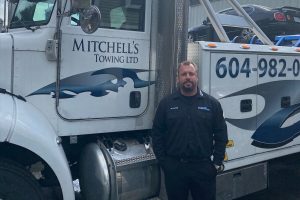Communication, training — and math — are all key for the crews who recover and lift heavy-duty vehicles from challenging terrain.

Photo credit: Mitchell Martin
It’s a heavy responsibility that requires advanced math skills.
“When you have a 100,000-pound load suspended in the air by a tow truck and have to move it as well, what kind of forces are you putting on the truck?” asks vehicle recovery professional Mitchell Martin, owner of Mitchell’s Towing in North Vancouver. It’s a familiar question to many auto recovery professionals. They often answer questions like this in their work to recover heavy-duty vehicles from highways, bodies of water, and other challenging terrain.
“If something goes wrong, it could be fatal. If a chain breaks, or you don’t rig the truck correctly, or your wire rope breaks — when you’re dealing with those kinds of weights, the chances of something catastrophic happening is much, much higher,” says Mitchell.
Communication is key
Mitchell stresses the importance of being able to communicate clearly during a recovery. He and his crew stay connected through wireless radio headsets that use the latest communication technology.
“Essentially we’re able to talk to each other as if I’m talking to you on the phone. It reduces blood pressure because you’re not yelling all the time. I can link to all members on my team,” Mitchell says. He adds that other crews arriving on scene can pair their headsets so they’re all connected.
“If cars are driving by and it’s raining, we don’t want to be on the side of the road yelling at each other. That’s when mistakes can happen because you don’t have clear communication.”
Advanced training improves success
Mitchell is one of 23 people in Canada (and only one of 3 in B.C.) who completed a new, advanced course for rigging, recovery, and incident management. This master-level course — WreckMaster’s Level 8/9 Living the Discipline — explores the more unusual scenarios faced by workers in this industry. They’re situations where advanced math, critical thinking, and leadership are essential.
A camera crew visited a course demonstration for this CTV News story. The demonstration showed how to lift a vehicle over an embankment or a body of water by suspending it some 6 metres in the air between two tow trucks. Obviously, it takes advanced math skills to measure and calculate the forces involved.
“We are often called to the scene on short notice without knowing what’s going on. We’ll have to make these calculations roadside,” Mitchell says. He tells me that many times they only get 15 minutes to work out the numbers. Highway maintenance wants them to clear the road as fast as they can.
The recent course gave participants a rare chance to practise their skills.
“There aren’t a lot of businesses that have cement mixers or tractor trailers to roll over, so there’s very little practice away from real-life situations. But in these particular classes, we had the opportunity to practise in private. When you get to practise and really study cases, it sets you up for success.”
For more information about the work of this industry, see my post Helping the auto recovery industry keep safety in tow. Also see WorkSafeBC’s Auto recovery & towing page and a towing and recovery safe work practices booklet, produced by the Automotive Retailers Association.
Thank you to to Mitchell Martin for talking to me about this work, and to this group of professionals on whom we rely so much.


